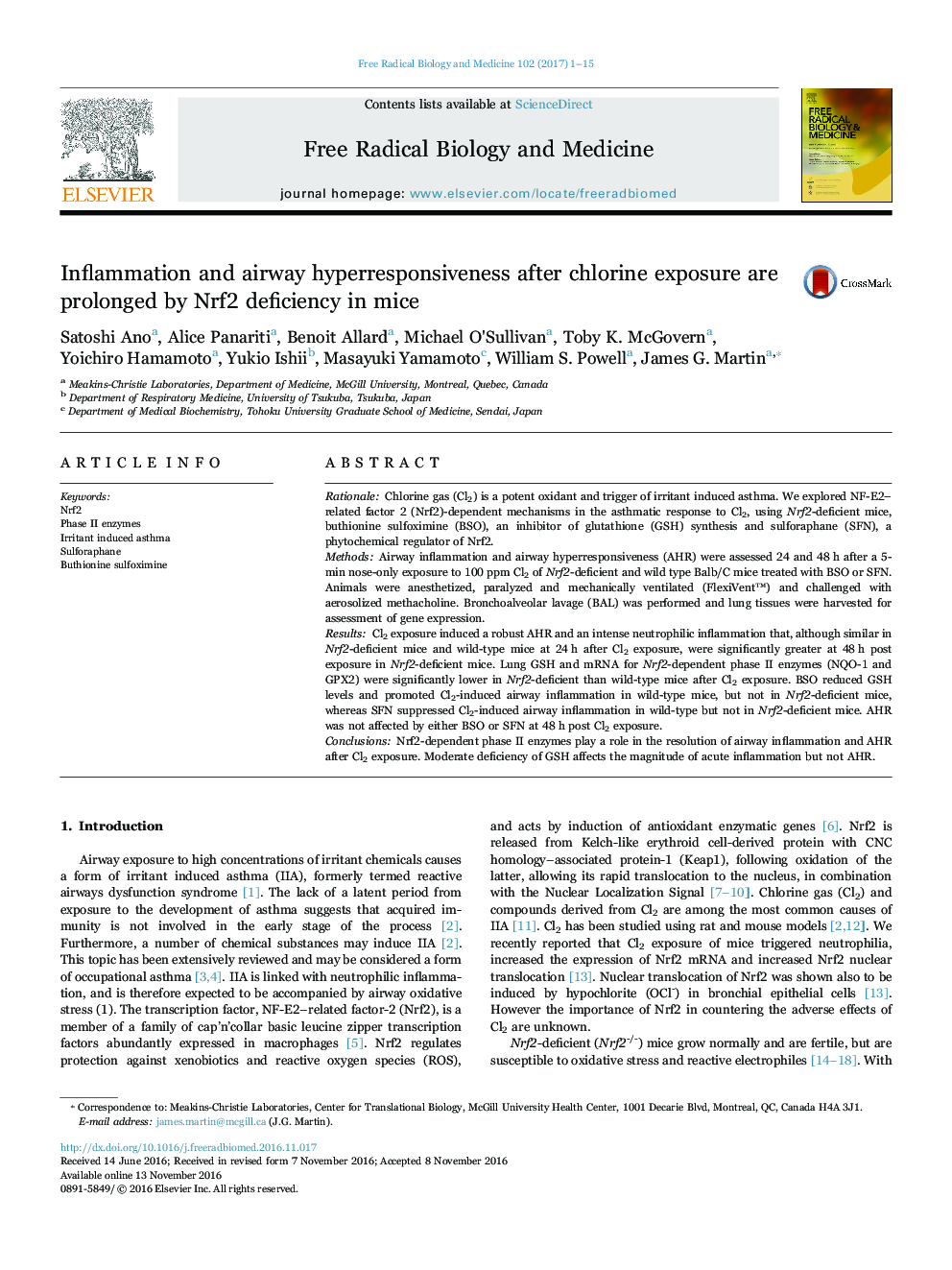| کد مقاله | کد نشریه | سال انتشار | مقاله انگلیسی | نسخه تمام متن |
|---|---|---|---|---|
| 5501986 | 1534941 | 2017 | 15 صفحه PDF | دانلود رایگان |
- Early airway dysfunction following chlorine exposure is Nrf2 independent.
- Nrf2 deficiency prolongs of airway dysfunction after Cl2 exposure.
- BSO affects the magnitude of acute inflammation but not AHR.
- SFN increases GSH and promotes resolution of inflammation but not AHR.
RationaleChlorine gas (Cl2) is a potent oxidant and trigger of irritant induced asthma. We explored NF-E2-related factor 2 (Nrf2)-dependent mechanisms in the asthmatic response to Cl2, using Nrf2-deficient mice, buthionine sulfoximine (BSO), an inhibitor of glutathione (GSH) synthesis and sulforaphane (SFN), a phytochemical regulator of Nrf2.MethodsAirway inflammation and airway hyperresponsiveness (AHR) were assessed 24 and 48 h after a 5-min nose-only exposure to 100 ppm Cl2 of Nrf2-deficient and wild type Balb/C mice treated with BSO or SFN. Animals were anesthetized, paralyzed and mechanically ventilated (FlexiVentâ¢) and challenged with aerosolized methacholine. Bronchoalveolar lavage (BAL) was performed and lung tissues were harvested for assessment of gene expression.ResultsCl2 exposure induced a robust AHR and an intense neutrophilic inflammation that, although similar in Nrf2-deficient mice and wild-type mice at 24 h after Cl2 exposure, were significantly greater at 48 h post exposure in Nrf2-deficient mice. Lung GSH and mRNA for Nrf2-dependent phase II enzymes (NQO-1 and GPX2) were significantly lower in Nrf2-deficient than wild-type mice after Cl2 exposure. BSO reduced GSH levels and promoted Cl2-induced airway inflammation in wild-type mice, but not in Nrf2-deficient mice, whereas SFN suppressed Cl2-induced airway inflammation in wild-type but not in Nrf2-deficient mice. AHR was not affected by either BSO or SFN at 48 h post Cl2 exposure.ConclusionsNrf2-dependent phase II enzymes play a role in the resolution of airway inflammation and AHR after Cl2 exposure. Moderate deficiency of GSH affects the magnitude of acute inflammation but not AHR.
Nrf2 activity and its modulation in response to chlorine. (A) Chlorine gas (Cl2) induces airway inflammation and airway hyperresponsiveness (AHR) in both Nrf2-deficient (Nrf2-/-) and wild-type (Nrf2+/+) mice at 24Â h after Cl2 exposure. (B) In wild type mice, Nrf2 translocates to the nucleus where it binds antioxidant response element and upregulates genes associated with glutathione synthesis and antioxidant defense. As consequence, 48Â h after Cl2 exposure mice expressing Nrf2 present decrease lung inflammation and resolution of AHR compared to Nrf2-/- mice. sulforaphane (SFN) stimulates Nrf2 nuclear translocation and an increase of the reduced form of glutathione leading to resolution of lung inflammation but not AHR in Nrf2+/+. The inhibition of GSH synthesis by buthionine sulfoximine (BSO) decrease the anti-oxidant defense leading to increased inflammation without affecting AHR. (C) In contrast, both SFN and BSO do not affect Cl2-induced airway inflammation and AHR at 48Â h after exposure in Nrf2-/- mice. Cl2, Chlorine gas; Nrf2, NF-E2-related factor 2; ARE, antioxidant response element; GPX2, glutathione peroxidase 2; GCLM, glutamate cysteine ligase modifier subunit; GST-P1, glutathione-S-transferase-P1; HO-1, heme-oxygenase 1; NQO1, NAD(P)H-quinone oxidoreductase 1; GSH, glutathione; GSSG, glutathione disulfide; AHR, airway hyperresponsiveness; SFN, sulforaphane; SOD1, superoxide dismutase 1; BSO, buthionine sulfoximine.216
Journal: Free Radical Biology and Medicine - Volume 102, January 2017, Pages 1-15
